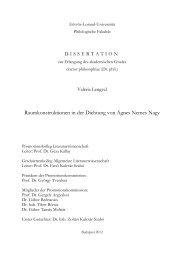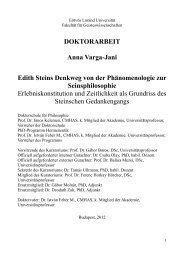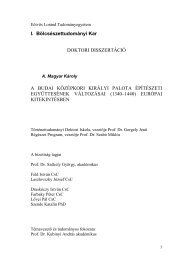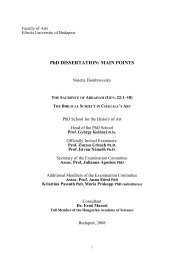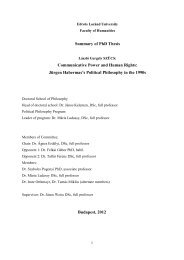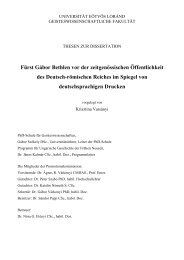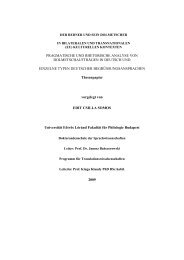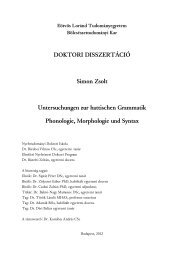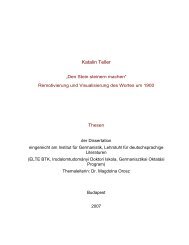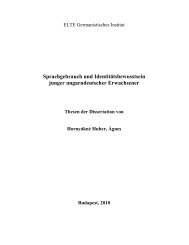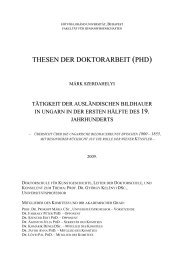Zsuzsanna Kutasi - ELTE BTK disszertációk
Zsuzsanna Kutasi - ELTE BTK disszertációk
Zsuzsanna Kutasi - ELTE BTK disszertációk
Create successful ePaper yourself
Turn your PDF publications into a flip-book with our unique Google optimized e-Paper software.
is examined in different ways by different authors, and they tend to have different<br />
interpretations in the case of any word. For example in the case of „sāq” the word means tibia<br />
(Classical Arabic L.), or cannon (in Saudi dialect), or else the bone of the forearm, or a lot of<br />
other things also 13 . “Ğubba” means ankle, hoof, or the two bones of the pastern. 14 “Dirā‘”<br />
means forearm (CAL), or cannon 15 . “Zawr” means the part of the thorax from the first rib to<br />
the sixth (CAL), or the throat 16 , and so on.<br />
2.2.Combinations between the terminology of the horse and the terminology of other animals.<br />
Sometimes one of the commentators think that the description refers to a camel or a<br />
wild donkey or something else, (for example, to an arrow), and not to a horse. See an<br />
example of this:<br />
ُزِوﺎﻌﻤﻟا ﺎﻬﻴﻠﻋ ْجَرﺪﺗ ﻢﻟو ًاﺮﻴﺒَﺣ ْﺖَﻣِﺮْآُأو ْﺖَﻨﻴﺻ ءاﺪﻧﻷا ﻂﻘﺳ اذإ -<br />
By the time the morning dew have fallen, it was wrapped up in fine clothes carefully not in<br />
worn rags, and great attention was paid to it. 17<br />
Here the verse deals with an arrow, and not with a noble horse, but the horse might also be<br />
drapped in fine clothes so that it should not catch a cold at dawn.<br />
ﺪﺻﺎﺣ ءﺎﺑﻷا ﻖﻳﺮﺣ<br />
6<br />
ﻪﻧﺄآ اوﺄﺷ ﻦﻴﻔﻄﻌﻟﺎﺑ ﺞﻟﺎﻌﻳ -<br />
Shows his two sides one after another on the hop as he is a fire piled up from pieces of wood<br />
by a reaper. 18<br />
We can find the same verse at the horse's description and at the wild ass also.<br />
ﻞﻈﻨﺣ ﺔﻳاﺮِﺻ وأ سوﺮﻋ كاﺪﻣ ىﺮﺟ اذا ﻪﻨﻣ ﻦﻴﻔﺘﻜﻟا ﻰﻠﻋ نﺄآ -<br />
Like on his two shoulders is the bride's little millstone for her eye-powder or the colocynt's<br />
juice. 19<br />
Both of them are yellow, but the horse's sweat is white therefore I think that we can read here<br />
about the camel instead.<br />
Sometimes we can see some names among the names of horse's body parts, which originally<br />
participated to the camel's or the sheep's terminology. For example „kalkal” (part of the chest,<br />
13<br />
Practical animal biology. Cairo, 1980. vols. 3<br />
14<br />
Ibn Sīda, al-muhaÒÒaÒ. Beirut n.d. vols 6/2. pp.145.<br />
15<br />
Carl Raswan, Vocabulary of Bedouin words. JNES 4/1945, Alois Musil, The Manners and customs of the<br />
Rwala Bedouins. New York, 1928.<br />
16<br />
Egyptian dialect (Kitāb al-ma‘ārif al-‘ilmī/ al-huyūl. Cairo,2001.), Janet C. Watson, Lexicon of Arabic Horse<br />
Terminology. London, 1996.<br />
17<br />
Dīwān al-Šammāh b. Âirār. Cairo, 1977. pp. 193.<br />
18<br />
Ibn Qutayba, al-ma’ānī al-kabīr / kitāb al-faras. Beirut 1953. pp. 18. and 28.<br />
19<br />
Ibn Qutayba, al-ma’ānī al-kabīr / kitāb al-faras. Beirut 1953. pp. 137.



